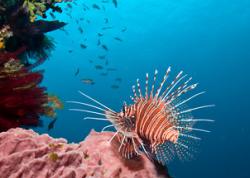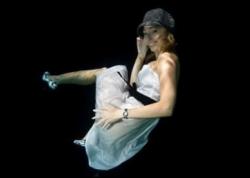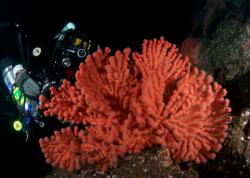Choosing a Macro Lens for Underwater Photography
Quick Links
Camera lens basics
Macro lens advice for topside photographers
Nikon 105mm VR macro lens review
First time cropped sensor dSLR users (Nikon D80, D90, D300, Canon 50D, 7d, etc) often ask the same question - which macro lens is better for underwater photography, the 60mm or 100mm/105mm? Canon choosers can choose the Canon 100mm. I don't recommend the sigma 105mm because of its slow auto-focus. Nikon users can choose the Nikon 105mm lens (old version or new VR version).
Because I own the Nikon lenses, I will refer to the Nikon 105mm macro lens, but the analysis equally applies to Canon users.
Even though I initially purchased both focal lengths, some people only have the budget for one lens. I want to discuss the differences between these focal lengths to help you make your choice. For nikon users, we will also discuss the difference between the "old versions" and the "new versions".
Dispelling Myths
I hear many myths regarding the difference between these lenses. Let's take a look at them.
One lens is "better" than the other. Absolutely not true - using a 60mm vs a 105mm will give you a different type of photo with a different feel. Read how lens choice affects composition.
Implying you should buy the lens that is "easiest to use". If you want to be a good photographer, you don't always want to take the easy route. The easiest route sometimes leads to photos that look like everyone else's.
A closer look at the 60mm lens
I know many people who begin dSLR underwater photography with a 60mm macro lens. This is the most common 1st choice for lens. It's quite versitile, good for fish, nudibranchs, and macro subjects in general. It's also good in lower vis, murkier water, and on night dives. I know many divers who mostly use the 60mm lens.
Let's look at some facts:
The 60mm lens has a 90mm effective focal length on a Nikon 1.5x cropped sensor dSLR
The 60mm lens has a 96mm effective focal length on a Canon 1.6x cropped sensor dSLR
Ideally used in a flat port designed for the 60mm lens, many people effectively use the lens in the port for the 100/105mm lens without problems.
The 60mm lens has a small working distance, which means you will be fairly close to the port when shooting small subjects.
When photographing fish, or subjects 4cm long or larger, using the 60mm lens behind a dome port also works well
A closer look at the 105mm lens
Some experience divers I know only use the 105mm lens for macro. How can some divers only use the 60mm, and others only the 100 or 105? It comes down to shooting style. Everyone has subjects and composition styles they prefer. These divers are usually shooting the same subjects, but getting different compositions.
Let's look at some facts:
The 105mm lens has a 157mm effective focal length on a Nikon 1.5x cropped sensor dSLR
The 100mm lens has a 160mm effective focal length on a Canon 1.6x cropped sensor dSLR
The 100/105mm lens is always used in a custom flat port for this lens.
The 100/105mm lens has a greater working distance than the 60mm lens, which means the subject will be a little further away from the port when shooting at small critters.
Read my Nikon 105mm VR review for more info.
Pros and Cons of the 60mm
Better on night dives, because of the better auto-focus
Better in low-visibility water, because you can get closer to your subject
Good for shots where you want to get a little of the background in the photo, but this can be a two-edged sworm, because the background can cause the photo to look cluttered

The 60mm macro lens is good for getting nudibranchs in their environment.

You can also get pretty close to objects with it, if the subject is not blocked by reef and doesn't move.

The 60mm can also take photos of larger fish.
Pros and Cons of the 100/105mm lens
Better for more dramatic compositions, such as close-ups, isolating the subject, or getting low
Better for skittish subjects such as small fish, gobies, mantis shrimp, that you may not be able to get close to.
Increased working distance makes it much easier to shoot subjects that are in rocky terrains
Longer focal length makes it easier to get pleasing blurred backgrounds. It also can be better for artistic shots where the view will be more compressed, giving the photo a more 2 dimensional look.
Best in clearer water, in very dark or low-vis water it can be a little difficult to focus.
Can often give a nice quality blurred background, or Bokeh

The 105mm lens allows you keep your distance. Even at F25, the background is blurred somewhat. With the 60mm, the background would be more cluttered, and the subject probably would have retracted into its tube. F25, ISO 320, 1/320th

The 105mm lens is great for closeups of small fish. F9, 1/200th, ISO 100. Channel islands, USA

By adding a 1.4x teleconverter onto the 105mm lens, it turns it into a 150mm lens on my D300 (225mm equivalent), good for the most skittish of all subjects, the zebra goby. F13, 1/320th, ISO 320
Which version- Old Nikon 60mm or New Nikon 60mm?
The new Nikon 60mm (AF-S) has slightly a faster auto-focus motor built in. However, both lenses are still F2.8 lenses, so both will have problems if there is not enough of contrast or light. I don't have any complaints about the auto-focus speed of my old 60mm lens, but faster is always better.
The older 60mm has 1 inch more working distance, a big plus when shooting close to 1:1.
the older 60mm works with the tamron/kenko 1.4x teleconverter, a great tool for supermacro.
Because of #2 and #3, I definitely will not be switching to the new 60mm. If you don't think you'll be using your 60mm for 1:1 macro shots or supermacro, you might be better off with the faster auto-focus of the new 60mm.
Which version - Old Nikon 105mm or New Nikon 105mm VR?
Both lenses have the same optical quality
The vibration reduction will be most useful in reducing camera shake. It cannot reduce motion blur. It is also most effective at longer distances. Because of this, the VR is most useful in topside photography.
The autofocus on the new version is better.
If you can afford it, get the new one, but don't hesitate to get the old one if that is the only one in your budget.
The new 105mm VR is a fatter lens, make sure your port choice supports the lens you choose. Double check with your housing manufacturer or uw camera shop.
Some people like to use a focus ring with this lens, make sure your port choice supports a focus ring.
Macro lens advice for topside photographers
Hands down, you want a 100/105mm focal length, not a 60mm lens. A 60mm lens does not have the working distance needed for insects, flowers, and other macro subjects. Some macro photographers even use longer lengths like a 150mm or 200mm focal length, but those lenses are more expensive for the same quality.
Conclusion
Ideally you would have both of these lenses in your underwater lens bag. If you can only afford 1 lens, and are still undecided, I suggest you read through the many pages of the composition chapter. There you will find many examples of shots with both lenses, maybe you will be drawn to one or the other.
Additional Resources
-
Taking great underwater macro photos
-
Underwater supermacro photography
-
Strobe positions
-
Underwater settings for macro
-
Best lenses for underwater use
-
How lens choice affects composition
-
Achieving a nice Bokeh effect
Featured Reading

RECOMMENDED ARTICLES
SUPPORT THE UNDERWATER PHOTOGRAPHY GUIDE:
The Best Service & Prices on u/w Photo Gear
 Visit Bluewater Photo & Video for all your underwater photography and video gear. Click, or call the team at (310) 633-5052 for expert advice!
Visit Bluewater Photo & Video for all your underwater photography and video gear. Click, or call the team at (310) 633-5052 for expert advice!
The Best Pricing, Service & Expert Advice to Book your Dive Trips
 Bluewater Travel is your full-service scuba travel agency. Let our expert advisers plan and book your next dive vacation. Run by divers, for divers.
Bluewater Travel is your full-service scuba travel agency. Let our expert advisers plan and book your next dive vacation. Run by divers, for divers.































